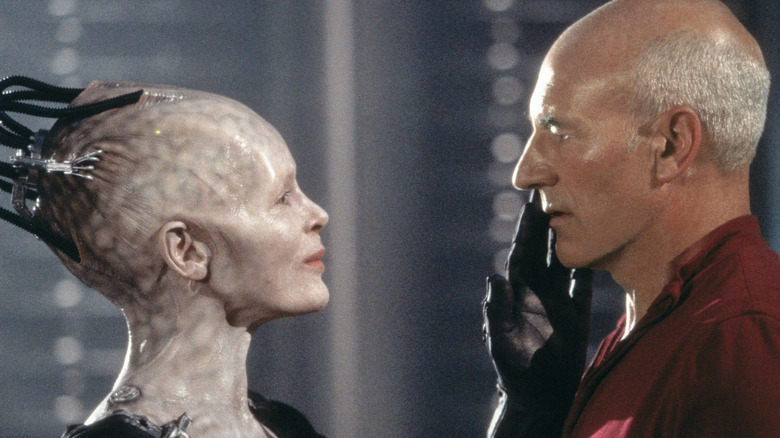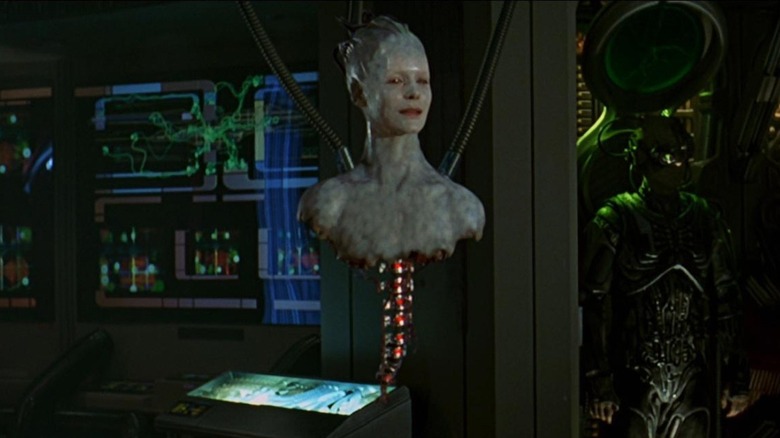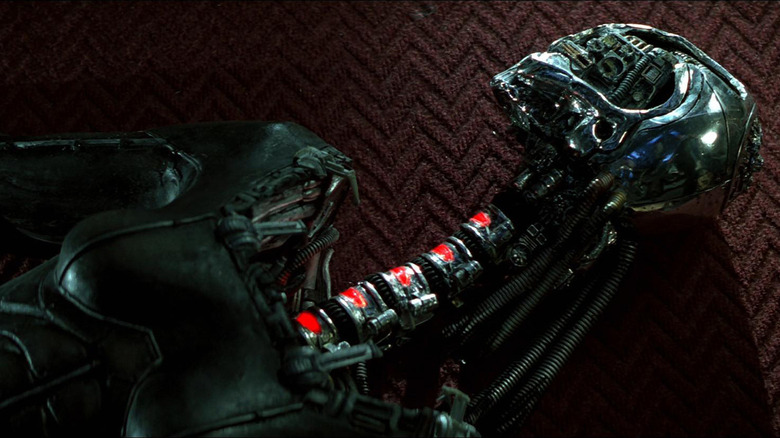Star Trek's Writers Didn't Invent The Borg Queen – A Paramount Executive Did
When the Borg were first introduced on "Star Trek: The Next Generation" (in the 1989 episode "Q Who"), they were terrifying. Clearly inspired by the works of H.R. Giger, the Borg sported tubes, servos, wires, and ineffable black machinery sprouting from their bodies. The Borg were made up of other species that had been kidnapped and assimilated into their collective, their minds wiped and replaced with a singular, terrifying machine consciousness. The Borg traversed space in outsized cube-shaped vessels, likewise crisscrossed with wires and ducts. They only had one goal: to grow. As Q (John de Lancie) described them, the Borg are the ultimate users. They look out at the universe and emotionlessly see nothing but raw materials to expand with.
The Borg returned periodically throughout "Next Generation," becoming one of the show's more impressive antagonists. The race of soulless machine people proved to be a great villain.
Naturally, when "Next Generation" moved into feature films, the Borg had to return. Jonathan Frakes' 1996 film "Star Trek: First Contact" featured the Borg traveling back in time to a vulnerable moment of Earth's history, hoping to alter events in their favor. In the past, the crew of the U.S.S. Enterprise discovered a new Borg wrinkle: they didn't have a group consciousness but were ruled by a sweaty, malevolent, emotional Queen (Alice Krige). Giving the Borg a "boss monster" was a silly twist that has, unfortunately, become a key part of "Star Trek" lore.
In the oral history book "The Fifty-Year Mission: The Next 25 Years: From The Next Generation to J. J. Abrams," edited by Mark A. Altman and Edward Gross, "First Contact" co-writer Brannon Braga revealed that the Borg Queen was invented by a Paramount executive named Jonathan Dolgen ... who thought the Borg were boring.
Hive?
To elucidate: "Star Trek: First Contact" is about a Borg attack on Earth that is cut short by the tactical savvy of Starfleet and the Enterprise-E. Just before their ship is destroyed, the Borg send a small spherical vessel through a mysterious time portal. The Enterprise pursues, getting caught briefly in a "time wake" and for a moment see that history has been altered. The Earth's population is now nine billion Borgs. The Enterprise goes back to the year 2063 to prevent their timeline alteration.
Audiences finally meet the Borg Queen a third of the way into the film. Unlike the other Borgs, the Queen is individualistic, sexual, and emotional and claims to speak for the Borg. Uncharacteristically, she states very specific goals. She was a fun, slinky, terrifying movie monster, but she made the Borg less threatening; the previously single-minded cyborgs now had a leader one could negotiate with.
Which is how Dolgen wanted it. The exec said that the Borg were dull, amounting to little more than robot zombies. They needed a voice. Screenwriter Brannon Braga hastened to come up with a "fix." Braga recalled:
"We did a substantial rewrite. Also, it was Jonathan Dolgen at the time who ran Paramount, the biggest cheese there was, and he was also a ravenous 'Star Trek' fan. Rick and I used to go into his office for meetings all the time, and he would say, 'Oh, I really like this episode and that episode.' I think he was the one who said the Borg are boring. They're just zombies, you need a voice. We thought, 'S***, okay, it's like a hive. Like a bee colony. Let's make a queen,' and it was probably the best invention we could have possibly come up with."
A hive? Sure.
Assimilate this
Turning the Borg into a hive made the villains a lot less interesting. Instead of being an unreasonable machine intelligence, there was now a hierarchy on board a Borg ship, with a "captain" calling the shots and the "drones" taking orders. And if the Queen was sexual and emotional, she was suddenly prone to trickery and manipulation herself. Indeed, in the climax of "First Contact," Data (Brent Spiner) hoodwinks the Borg Queen; she is emotionally distracted enough to let Data (Brent Spiner) re-aim the ship's torpedos.
But Braga was just following orders from Paramount, and a Borg Queen was his most elegant solution. At least the change was demanded by a Trekkie with his own vision of the franchise, and not an ignorant moneyman looking for toyetic images.
Early in the scriptwriting process, it seemed that Commander Riker (Jonathan Frakes) was to be the hero. Braga realized that Picard should be the one to face off against the Borg again, saying:
"I don't think anyone realized by shuffling Picard and Riker around it would change things so monumentally, but I'm glad it did. Because it was the next movie, and it had been two years since you had last seen Picard, you kind of wanted to do big things with him. You wanted to have him fall in love and take a woman with him at the end. Actually, it was a good instinct on Patrick's part, because you want to see these characters in new situations. But this is an action movie. A romance? What a stupid idea. In the rewrite, the Borg meets the captain and he's our action hero."
"First Contact," despite its action film trappings, was a big hit, and is often considered the best of the "NextGen" movies. A Hive it is.


